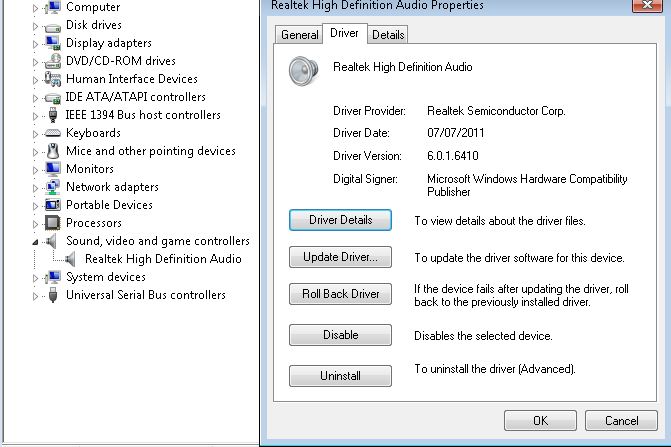Realtek HD Audio Driver Revision History – Windows 2000 x86 and Windows XP x86/x64
R2.71 – 5.10.0.6873 –
R2.70 – 5.10.0.6662 –
R2.69 – 5.10.0.6649 –
R2.68 – 5.10.0.6602 –
R2.67 – 5.10.0.6526 –
R2.66 – 5.10.0.6482 –
R2.65 – 5.10.0.6449 –
R2.64 – 5.10.0.6438 –
R2.63 – 5.10.0.6410 –
R2.62 – 5.10.0.6392 –
R2.61 – 5.10.0.6383 –
R2.60 – 5.10.0.6363 –
R2.59 – 5.10.0.6343 –
R2.58 – 5.10.0.6316 –
R2.57 – 5.10.0.6299 –
R2.56 – 5.10.0.6278 –
R2.55 – 5.10.0.6257 –
R2.54 – 5.10.0.6235 –
R2.53 – 5.10.0.6215 –
R2.52 – 5.10.0.6194 –
R2.51 – 5.10.0.6167 –
R2.50 – 5.10.0.6151
R2.49 – 5.10.0.6132
R2.48 – 5.10.0.6101
R2.47 – 5.10.0.6083
R2.46 – 5.10.0.6077
R2.45 – 5.10.0.6069
R2.44 – 5.10.0.6066
R2.43 – 5.10.0.6050
R2.42 – 5.10.0.6043
R2.41 – 5.10.0.6029
R2.40 – 5.10.0.6013
R2.39 – 5.10.0.6000
R2.38 – 5.10.0.5995
R2.37 – 5.10.0.5983
R2.36 – 5.10.0.5969
R2.35 – 5.10.0.5953
R2.34 – 5.10.0.5943
R2.33 – 5.10.0.5936
R2.32 – 5.10.0.5928
R2.31 – 5.10.0.5919
R2.30 – 5.10.0.5911
R2.29 – 5.10.0.5898
R2.28 – 5.10.0.5888
R2.27 – 5.10.0.5874
R2.26 – 5.10.0.5864
R2.25 – 5.10.0.5859
R2.24 – 5.10.0.5854
R2.23 – 5.10.0.5845
R2.22 – 5.10.0.5832
R2.21 – 5.10.0.5821
R2.20 – 5.10.0.5817
R2.19 – 5.10.0.5809
R2.18 – 5.10.0.5804
R2.17 – 5.10.0.5794
R2.16 – 5.10.0.5791
R2.15 – 5.10.0.5783
R2.14 – 5.10.0.5772
R2.13 – 5.10.0.5767
R2.12 – 5.10.0.5764
R2.11 – 5.10.0.5755
R2.10 – 5.10.0.5745
R2.09 – 5.10.0.5735
R2.08 – 5.10.0.5730
R2.07 – 5.10.0.5717
R2.06 – 5.10.0.5713
R2.05 – 5.10.0.5708
R2.04 – 5.10.0.5700
R2.03 – 5.10.0.5694
R2.02 – 5.10.0.5683
R2.01 – 5.10.0.5680
R2.00 – 5.10.0.5672
R1.99 – 5.10.0.5667
R1.98 – 5.10.0.5657
R1.97 – 5.10.0.5653
R1.96 – 5.10.0.5643
R1.95 – 5.10.0.5636
R1.94 – 5.10.0.5628
R1.93 – 5.10.0.5624
R1.92 – 5.10.0.5618
R1.91 – 5.10.0.5605
R1.90 – 5.10.0.5591
R1.89 – 5.10.0.5582
R1.88 – 5.10.0.5574
R1.87 – 5.10.0.5567
R1.86 – 5.10.0.5559
R1.85 – 5.10.0.5548
R1.84 – 5.10.0.5532
R1.83 – 5.10.0.5523
R1.82 – 5.10.0.5512
R1.81 – 5.10.0.5506
R1.80 – 5.10.0.5497
R1.79 – 5.10.0.5490
R1.78 – 5.10.0.5485
R1.77 – 5.10.0.5480
R1.76 – 5.10.0.5477
R1.75 – 5.10.0.5473
R1.74 – 5.10.0.5470
R1.73 – 5.10.0.5464
R1.72 – 5.10.0.5449
R1.71 – 5.10.0.5443
R1.70 – 5.10.0.5436
R1.69 – 5.10.0.5433
R1.68 – 5.10.0.5413
R1.67 – 5.10.0.5413
R1.66 – 5.10.0.5404
R1.65 – 5.10.0.5397
R1.64 – 5.10.0.5391
R1.63 – 5.10.0.5377
R1.62 – 5.10.0.5377
R1.61 – 5.10.0.5377
R1.60 – 5.10.0.5366
R1.59 – 5.10.0.5366
R1.58 – 5.10.0.5366
R1.57 – 5.10.0.5366
R1.56 – 5.10.0.5345
R1.55 – 5.10.0.5345
R1.54 – 5.10.0.5345
R1.53 – 5.10.0.5324
R1.52 – 5.10.0.5324
R1.51 – 5.10.0.5324
R1.50 – 5.10.0.5319
R1.49 – 5.10.0.5319
R1.48 – 5.10.0.5317
R1.47 – 5.10.0.5296
R1.46 – 5.10.0.5294
R1.45 – 5.10.0.5288
R1.44 – 5.10.0.5286
R1.43 – 5.10.0.5283
R1.42 – 5.10.0.5282
R1.41 – 5.10.0.5273
R1.40 – 5.10.0.5268
R1.39 – 5.10.0.5265
R1.38 – 5.10.0.5257
R1.37 – 5.10.0.5253
R1.36 – 5.10.0.5247
R1.35 – 5.10.0.5242
R1.34 – 5.10.0.5233
R1.33 – 5.10.0.5229
R1.32 – 5.10.0.5224
R1.31 – 5.10.0.5221
R1.30 – 5.10.0.5211
R1.29 – 5.10.0.5202
R1.28 – 5.10.0.5200
R1.27 – 5.10.0.5188
R1.26 – 5.10.0.5178
R1.25 – 5.10.0.5172
R1.24 – 5.10.0.5152
R1.23 – 5.10.0.5136
R1.22 – 5.10.0.5128
R1.21 – 5.10.0.5127
R1.20 – 5.10.0.5125
R1.19 – 5.10.0.5123
R1.18 – 5.10.0.5122
R1.17 – 5.10.0.5120
R1.16 – 5.10.0.5119
R1.15 – 5.10.0.5116
R1.14 – 5.10.0.5109
R1.13 – 5.10.0.5038
R1.12 – 5.10.0.5037
R1.11 – 5.10.0.5036
R1.10 – 5.10.0.5034
R1.09 – 5.10.0.5033
R1.08 – 5.10.0.5032
R1.07 – 5.10.0.5031
R1.06 – 5.10.0.5030
R1.05 – 5.10.0.5029
R1.04 – 5.10.0.5028
R1.03 – 5.10.0.5027
R1.02 – 5.10.0.5022
R1.01 – 5.10.0.5022
R1.00 – 5.10.0.5017
Windows 2000 and Windows XP – Realtek HD Audio Device Driver Support is available for the following Devices and HD Audio Chipsets:
ALC880
ALC882
ALC883
ALC885
ALC886
ALC887
ALC888
ALC889
ALC892
ALC899
ALC861VC
ALC861VD
ALC660
ALC662
ALC663
ALC665
ALC670
ALC671
ALC672
ALC676
ALC680
ALC221
ALC231
ALC260
ALC262
ALC267
ALC268
ALC269
ALC270
ALC272
ALC273
ALC275
ALC276
ALC280
ALC282
ALC290

